Hyundai Ioniq (AE): Brake System / Brake bleeding procedures
| Integrated Electronic Brake (IEB) System Air Bleeding Procedures |
| •
| Do not reuse the drained fluid. |
| •
| Always use genuine DOT3 or DOT4 brake Fluid. Using a non-genuine DOT3 or DOT4 brake fluid can cause corrosion and decrease the life of the system. ※ However, do not use the 01100-00110 (for Equus 4.5GDI) of DOT3 or DOT4. |
| •
| Make sure no dirt or other foreign matter is allowed to contaminate the brake fluid. |
| •
| Do not spill brake fluid on the vehicle, it may damage the paint; if brake fluid does contact the paint, wash it off immediately with water. |
| •
| The reservoir on the master cylinder must be at the MAX (upper) level mark at the start of bleeding procedure and checked after bleeding each brake caliper. Add fluid as required. |
|
Air Bleeding Tool (09580-3D100) Installation Procedure
| •
| To prevent the brake fluid reservoir tank from being damaged and ensure the safety of worker, set the pressure of the gauge to the standard value before installing the SST. |
|
| 1. | Before installing the SST on the vehicle, close the airshut-off valve (A) to adjust the pressure gauge to the standard value. 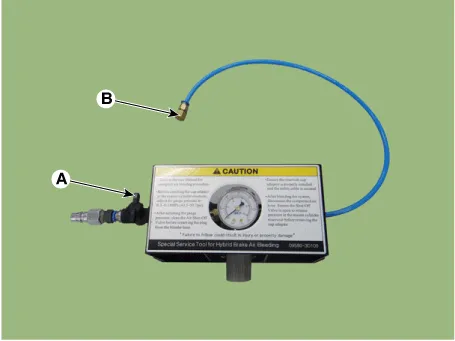
| •
| For safety of worker and correct pressure setting,make sure that the plug (B) is installed correctly. |
|
|
| 2. | After connecting an air hose and opening the airshut-off valve (A), adjust the pressure gauge (B) withto the standard value. Standard pressure value : 3 bar |
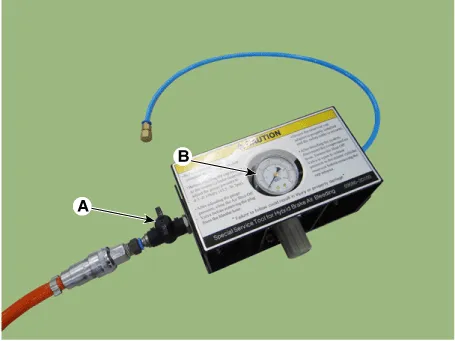
|
| 3. | Close the air shut off valve (A) and remove the plug (B). 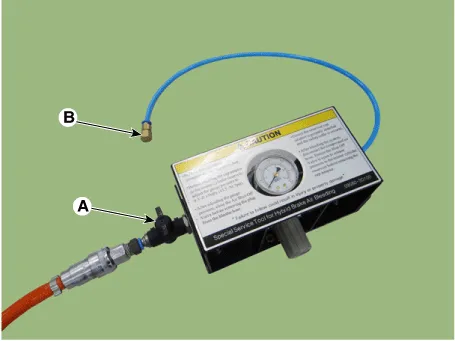
| •
| For safety of worker, make sure that the air shut off valve is closed and remove the plug. |
|
|
| 4. | Remove the brake reservoir tank cap. |
| 5. | Install the cap (A) of SST (0K585-E8100) on the reservoir tank. 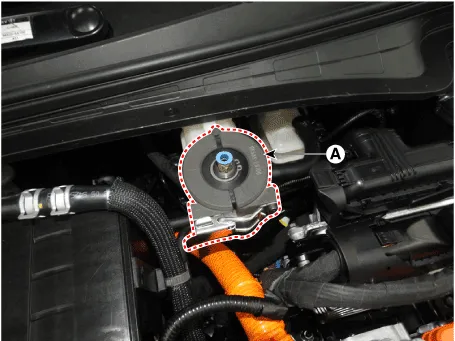
|
| 6. | Make sure the check valve (A) is closed and connect SST (09580-3D100) (A) to the adapter (B). 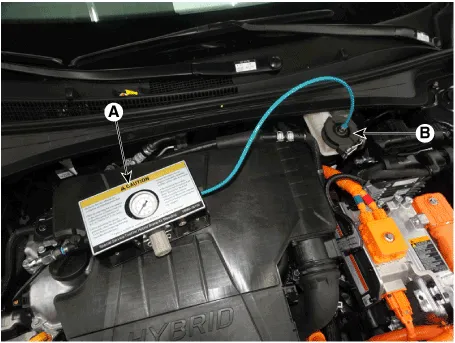
|
Air Bleeding Tool (09580-3D100) Removal Procedure
| 1. | Close the air shut-off valve (A) first, after disconnecting the air hose (B), bleed air in the reservoir tank by opening the air shut-off valve (A) slowly. 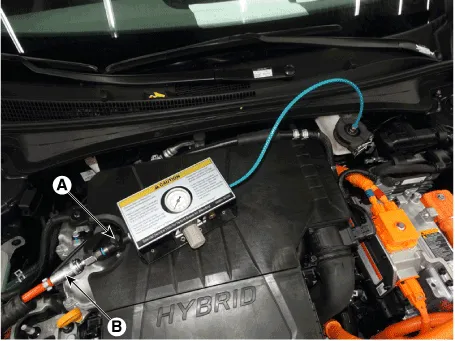
| •
| To prevent backflow of brake fluid, be sure to open the air shut-off valve slowly then bleed air in the reservoir tank. |
|
|
| 2. | Remove SST (09580-3D100) and the cap of SST (0K585-E8100) on the reservoir tank. 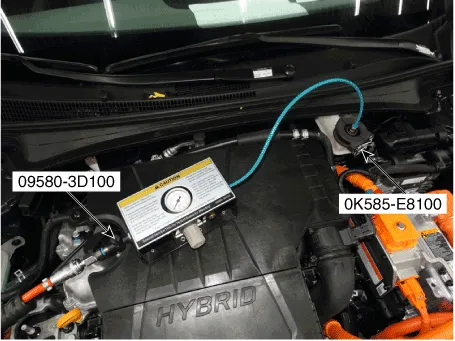
|
| 3. | Inatall the brake reservoir tank cap. |
Integrated Electronic Brake (IEB) System Air Bleeding
In case of IEB replacement, perform the air bleeding procedures.
| •
| Do not reuse the drained fluid. |
| •
| Always use genuine DOT3 or DOT4 brake Fluid. Using a non-genuine DOT3 or DOT4 brake fluid can cause corrosion and decrease the life of the system. |
| •
| Make sure no dirt or other foreign matter is allowed to contaminate the brake fluid. |
| •
| Do not spill brake fluid on the vehicle, it may damage the paint; if brake fluid does contact the paint, wash it off immediately with water. |
| •
| When bleeding air, make sure the brake fluid is above10mm starting from the "MIN" line. |
| •
| To remove the reservoir tank cap to refill the brake fluid, always close the air shut-off valve of the SST. |
|
| 1. | Disconnect the negative (-) battery terminal to turn off IEB ECU. |
| 2. | Refill the reservoir to MAX (upper) level line. Brake fluid : DOT3 or DOT4 |
|
| 3. | Set the air bleeding tool (SST : 09580-3D100) and the cap of SST (0K585-E8100) to reservoir tank and make pressure (3 bar) to it. |
| 4. | Lock the bleed screw after steping on brake pedal 10~20 times in condition of break fluid has been drained out for 10 seconds after opening each bleed screws(A). Tightening torque : 6.9 - 12.7 N.m (0.7 - 1.3 kgf.m, 5.1 - 9.4 lb-ft) |
| •
| To improve the work efficiency bleed the air in the following order: FR → FL → RL → RR. |
| •
| If the brake fluid goes below 'MIN' while working, remove the pressure feeder and mount the pressrue feeder after filling the brake fluid in the reservoir. Repeat the procedure for wheel in the sequence shown below until air bubbles no longer appear in the fluid. |
| •
| Be careful not to open the bleed screw too much as the air may get inside the pipe. |
|
[Front] 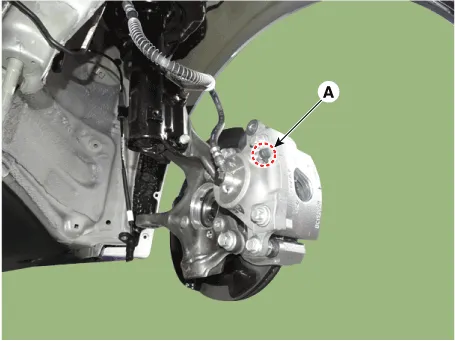
[Rear] 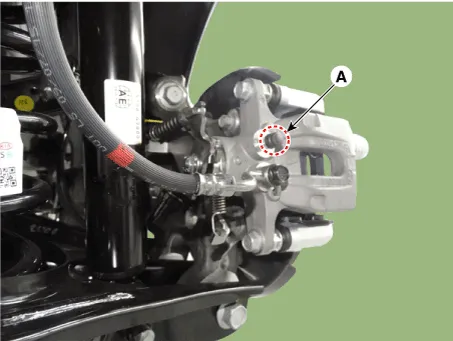
|
| 5. | Remove the air bleeding tool carefully. |
| 6. | Refill the reservoir to "MAX" level line. |
| 7. | Connect the negative (-) battery terminal to turn on IEB ECU. |
| 8. | Perform the "Fluid Circulation Mode" by diagnostic tool following in the order below. | (1) | Connect self-diagnosis connector (16 pins) located under the driver side crash pad to self-diagnosis device, and then turn the self-diagnosis device after key is ON. |
| (2) | Select the "Vehicle model" and "ESC" on diagnostic tool vehicle selection screen. |
| (3) | Select the "Fluid Circulation Mode" on diagnostic tool screen, then select OK. |
| (4) | Proceed with the test according to the screen instructions. 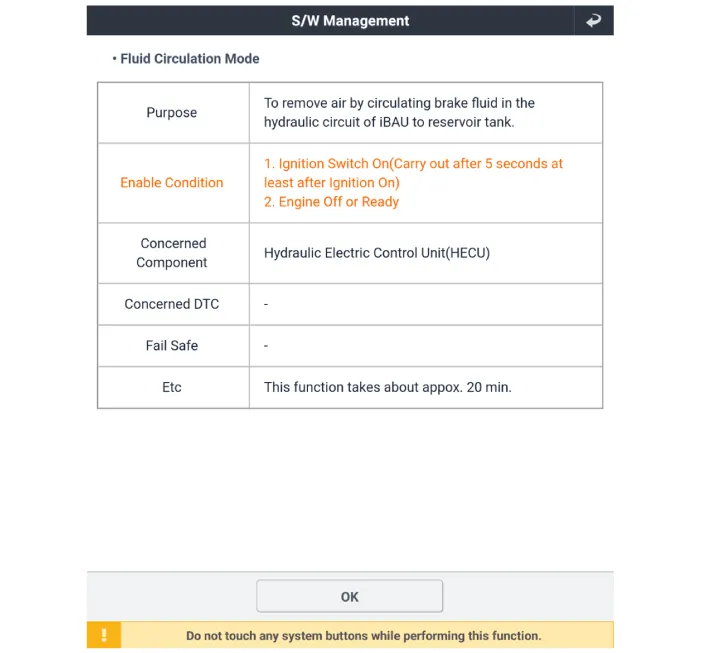
|
| (5) | Detach the diagnostic tool after "Fluid Circulation Mode" is done. |
|
| 9. | Disconnect the negative (-) battery terminal to turn off IEB ECU. |
| 10. | Refill the reservoir to MAX (upper) level line. Brake fluid : DOT3 or DOT4 |
|
| 11. | Set the air bleeding tool (SST : 09580-3D100) and the cap of SST (0K585-E8100) to reservoir tank and make pressure (3 bar) to it. |
| 12. | Lock the bleed screw after steping on brake pedal 10~20 times in condition of break fluid has been drained out for 10 seconds after opening each bleed screws(A). Tightening torque : 6.9 - 12.7 N.m (0.7 - 1.3 kgf.m, 5.1 - 9.4 lb-ft) |
| •
| To improve the work efficiency bleed the air in the following order: FR → FL → RL → RR. |
| •
| If the brake fluid goes below 'MIN' while working, remove the pressure feeder and mount the pressrue feeder after filling the brake fluid in the reservoir. Repeat the procedure for wheel in the sequence shown below until air bubbles no longer appear in the fluid. |
| •
| Be careful not to open the bleed screw too much as the air may get inside the pipe. |
|
[Front] 
[Rear] 
|
| 13. | Remove the air bleeding tool carefully. |
| 14. | Refill the reservoir to "MAX" level line. |
| 15. | Connect the negative (-) battery terminal to turn on IEB ECU. |
| 16. | Repeat the above procedure if air leaking process has not done properly after the procedure is done. | •
| "Fluid Circulation Mode" has to be done with 20 min. of interval to not damage the parts by Integrated Electronic Booster (IEB). |
|
|
Brake System Air Bleeding
In case of brake caliper and brake line replacement, perform the air bleeding procedures.
| •
| Do not reuse the drained fluid. |
| •
| Always use genuine DOT3 or DOT4 brake Fluid. Using a non-genuine DOT3 or DOT4 brake fluid can cause corrosion and decrease the life of the system. |
| •
| Make sure no dirt or other foreign matter is allowed to contaminate the brake fluid. |
| •
| Do not spill brake fluid on the vehicle, it may damage the paint; if brake fluid does contact the paint, wash it off immediately with water. |
| •
| When bleeding air, make sure the brake fluid is above10mm starting from the "MIN" line. |
| •
| To remove the reservoir tank cap to refill the brake fluid, always close the air shut-off valve of the SST. |
|
| 1. | Disconnect the negative (-) battery terminal to turn off IEB ECU. |
| 2. | Refill the reservoir to MAX (upper) level line. Brake fluid : DOT3 or DOT4 |
|
| 3. | Set the air bleeding tool (SST : 09580-3D100) and the cap of SST (0K585-E8100) to reservoir tank and make pressure (3 bar) to it. |
| 4. | Lock the bleed screw after steping on brake pedal 10~20 times in condition of break fluid has been drained out for 10 seconds after opening each bleed screws(A). Tightening torque : 6.9 - 12.7 N.m (0.7 - 1.3 kgf.m, 5.1 - 9.4 lb-ft) |
| •
| To improve the work efficiency bleed the air in the following order: FR → FL → RL → RR. |
| •
| If the brake fluid goes below 'MIN' while working, remove the pressure feeder and mount the pressrue feeder after filling the brake fluid in the reservoir. Repeat the procedure for wheel in the sequence shown below until air bubbles no longer appear in the fluid. |
| •
| Be careful not to open the bleed screw too much as the air may get inside the pipe. |
|
[Front] 
[Rear] 
|
| 5. | Remove the air bleeding tool carefully. |
| 6. | Refill the reservoir to "MAX" level line. |
| 7. | Connect the negative (-) battery terminal to turn on IEB ECU. |
| 8. | Repeat the above procedure if air leaking process has not done properly after the procedure is done. |
Troubleshooting
Symptom
Suspect Area
Reference
Lower pedal or spongy pedal1.
Other information:
Replacement1.Disconnect the negative (-) battery terminal. 2.Remove the heater and blower assembly.(Refer to Heater - "Heater Unit") 3.Loosen the mounting screws and remove the driver's temperature control actuator (A).4.Remove the heater core cover (A) after loosening the mounting screws.
C












